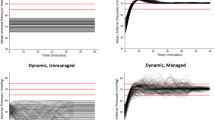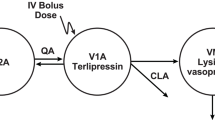Abstract
Purpose. Prolonged continuous administration of nitroglycerin (NTG) leads to hemodynamic tolerance. We used a previously developed pharmacokinetic-pharmacodynamic (PK/PD) model of NTG tolerance in experimental heart failure to test whether dosage regimens, designed from this model, may allow avoidance of tolerance development upon continuous NTG inftision.
Methods. Simulation experiments (using ADAPT II) were performed to evolve a time-variant infusion regimen that would theoretically provide sustained hemodynamic effect (30% reduction in left ventricular end-diastolic pressure, LVEDP) throughout 10 hours of drug dosing. A computer controlled infusion pump was utilized to deliver this time-variant input. Infusion experiments were then conducted in CHF rats to challenge the predictability of the applied PK/PD model.
Results. Simulations showed that exponentially increasing input functions provided more sustained LVEDP effects when compared to linear or hyperbolic input functions delivering the same total NTG dose. A computer-selected infusion regimen of 6.56e0.00156×minutes μg/min was anticipated to provide the desired hemodynamic profile in our animal model. Experiments conducted in rats with congestive heart failure (n = 4) confirmed the prediction of sustained hemodynamic effect without tolerance (28 ± 4% reduction in LVEDP at 10 hrs).
Conclusions. These findings support the utility of our PK/PD model of NTG tolerance in predicting NTG action, and serve as an example of therapeutic optimization through PK/PD considerations.
Similar content being viewed by others
REFERENCES
J. Abrams. Am. Heart J. 110:216–24 (1985).
U. Elkayam. Ann. Intern. Med. 114:667–77 (1991).
J. A. Bauer and H. L. Fung Pharm. Res. 11:816–23 (1994).
J. O. Parker. Brit. J. Clin. Pharmacol. 34:11S–14S (1992).
P. Needleman and E. Johnson. Jr. J. Pharmacol. Exp. Ther. 184:709–15 (1973).
J. O. Parker and J. D. Parker. Amer. J. Cardiol. 70:93B–97B (1992).
H. Drexler, E. J. Toggart, M. R. Glick, J. Heald, S. F. Flaim, R. Zelis, J. Amer. Coll. Cardiol. 8:134–42 (1986).
N. Sharpe, R. Coxon, M. Webster, and R. Luke. Am. J. Cardiol. 59:895–9 (1987).
U. Elkayam, D. Kulick, N. McIntosh, A. Roth, W. Hsueh, and S. H. Rahimtoola. Circulation 76:577–84 (1987).
J. A. Bauer and H. L. Fung. Circulation 84:35–39 (1991).
J. A. Bauer and H. L. Fung. J. Pharmacol. Exp. Ther. 256:249–54 (1991).
D. Z. D'Argenio and A. Schumitzky. ADAPT II User's Guide. (1992).
M. Ferratini, S. Pirelli, P. Merlini, P. Silva, and G. Pollavini. Eur. Heart J. 10:998–1002 (1989).
J. O. Parker. J. Amer. Coll. Cardiol. 13:794–5 (1989).
H. L. Fung. Am. J. Med. 76:22–6 (1984).
J. M. Bailey, I. M. Schwieger, and C. Hug. Jr. Anesth. & Analges. 76:247–52 (1993).
J. B. Dyck, M. Maze, C. Haack, D. L. Azarnoff, L. Vuorilehto, and S. L. Shafer. Anesthes. 78:821–8 (1993).
S. L. Shafer and K. M. Gregg. J. Pharm. Biopharm. 20:147–69 (1992).
S. L. Shafer and J. R. Varvel. Anesthesiology 74:53–63 (1991).
J. A. Bauer and H. L. Fung. Cardiovasc. Res. 24:198–203 (1990).
J. O. Parker and J. D. Parker. Amer. J. Cardiol. 70:93B–97B (1992).
H. L. Fung and J. A. Bauer. Cardiovasc. Drugs & Ther. 8:489–99 (1994).
S.-J. Chung and H.-L. Fung. Biochem. Pharmacol. 45:157–163 (1993).
A. Haj-Yehia and L. Z. Benet. J. Pharmacol. Exp. Ther. 278:1296–1305 (1996).
T. Munzel, A. Giaid, S. Kurz, D. J. Stewart, and D. Harrison. Proc. Nat. Acad. Sci. USA 92:5244–8 (1995).
T. Münzel, H. Sayegh, B. A. Freeman, M. M. Tarpey, and D. G. Harrison. J. Clin. Invest. 95:187–194, (1995).
A. Mehra, A. Shotan, E. Ostrzega, J. Vasquez-Johnson, and U. Elkayam. Am. Heart J. 130:798–805 (1995).
Author information
Authors and Affiliations
Corresponding author
Rights and permissions
About this article
Cite this article
Bauer, J.A., Balthasar, J.P. & Fung, HL. Application of Pharmacodynamic Modeling for Designing Time-Variant Dosing Regimens to Overcome Nitroglycerin Tolerance in Experimental Heart Failure. Pharm Res 14, 1140–1145 (1997). https://doi.org/10.1023/A:1012138320003
Issue Date:
DOI: https://doi.org/10.1023/A:1012138320003




